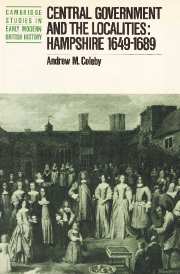Book contents
- Frontmatter
- Contents
- List of maps
- Acknowledgements
- List of abbreviations
- INTRODUCTION AND PROLOGUE
- PART I THE INTERREGNUM
- PART II THE RESTORATION
- THE RESTORED MONARCHY AND THE ROLE OF GOVERNMENT
- 4 LOCAL OFFICE-HOLDING 1660–78
- 5 THE ENFORCEMENT OF POLICY 1660–78
- 6 COURT AND COUNTY 1660–78
- PART III FROM THE POPISH PLOT TO THE REVOLUTION OF 1688
- EPILOGUE AND CONCLUSION
- Bibliography
- Index
THE RESTORED MONARCHY AND THE ROLE OF GOVERNMENT
Published online by Cambridge University Press: 14 October 2009
- Frontmatter
- Contents
- List of maps
- Acknowledgements
- List of abbreviations
- INTRODUCTION AND PROLOGUE
- PART I THE INTERREGNUM
- PART II THE RESTORATION
- THE RESTORED MONARCHY AND THE ROLE OF GOVERNMENT
- 4 LOCAL OFFICE-HOLDING 1660–78
- 5 THE ENFORCEMENT OF POLICY 1660–78
- 6 COURT AND COUNTY 1660–78
- PART III FROM THE POPISH PLOT TO THE REVOLUTION OF 1688
- EPILOGUE AND CONCLUSION
- Bibliography
- Index
Summary
Many parts of the traditional structure of royal government were revived in 1660, at least nominally. The Privy Council, the Exchequer, the secretaries of state, were all re-established, though these institutions or ones closely resembling them had existed in the 1650s, or at least during the Cromwellian Protectorate. In other respects, the restoration was only partial. Some of the most effective instruments of central government in the pre-Civil War period, Star Chamber, High Commission, the Council of the North, were not revived. Nor did institutional development cease at the Restoration, as the Privy Council continued to decline, whilst other departments, like the Treasury and the secretary of state's office rose in importance. The royal court, informal and pluralistic though it was, was once again the centre of patronage and policy making; but the existence of a ‘standing Parliament’ for much of the first twenty years of Charles II's reign meant that it did not operate as such in a vacuum.
The Restoration government deserves to be taken seriously as it sought to tackle the problems facing the post-Civil War state: defence, security, finance and religion, in the localities. The constraints upon the regime were largely psychological after the failure of some ‘Presbyterian’ politicians to impose terms upon the king, and opportunities existed for really effective government.
- Type
- Chapter
- Information
- Central Government and the LocalitiesHampshire 1649-1689, pp. 87 - 88Publisher: Cambridge University PressPrint publication year: 1987

